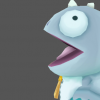-
Posts
23 -
Joined
-
Last visited
Contact Methods
-
Website URL
http://wub-wub.com
Profile Information
-
Gender
Male
Recent Profile Visitors
1,174 profile views
Cowtail's Achievements

Neophyte (2/11)
8
Reputation
-
That number 2 front/side profile shot of him reminds me of some old-time British actor or something...but can't recall who exactly! The older painted version not so much, which is probably a good thing Any special plans for this guy?
-
I agree, looks like he's got spunk-in-progress Looking forward to the final result!
-
Nice work everyone!
-
Ugh, so I finally got to come back to this guy, and redid the fur on the chest and knees, filled the mouth with teeth and tongue, eyelids (not shown), and some minor detailing. I'm thinking of detailing most of the body with fur, if I don't get it to look right then screw it :P
-
Hm, I have a Sony Vaio Flip 15A. It uses the N-Trig active pen, which is also what the new Surface Pros have (if you have the older Wacom version, that's much better--I used to have one). Problem is that the Surface Pros have a small screen size--even with high resolution there's a bit of squinting if you turn off that custom display scaling of software. The N-Trig pen isn't very good, in terms of its two buttons. Horrible, in fact, since you can't customize what the two buttons do--they use the windows stylus interface. One is right-click, the other is...something else that doesn't do anything for 3DC :P. Pressure sensitivity is spot-on, but unless you have a keyboard or 3D mouse to supplement it, there'll be a lot of play with the ui as you sculpt, especially if you don't have ctrl-z/ctrl-y/alt or any of your favorite hotkeys. Performance-wise, my laptop started struggling with voxels at 7.7mil, but in surface mode with that resolution the operations were pretty good. The new Surface Pros would probably be about the same in terms of performance, though I don't think it has dedicated graphics acceleration so there's probably a performance hit there. You might want to bump down the desktop resolution if everything gets too choppy. I'm thinking of writing a simple wrapper/interceptor for the pen so that it'll play better with 3D-coat and other paint applications, with on-screen modifier buttons. I haven't gotten around to it yet since I primarily use my desktop and wacom tablet for this stuff.
-
Just a suggestion, but try adding a few more divisions on the retopo mesh at the areas that are wavy, and perhaps separate the UVs for them so that they are their own islands with less distortion. As in the attached image, make the red parts their own islands and add more divisions (blue parts). Not sure if it'll fix it, but worth a try!
-
Hi Javis, yeah that's his email response. Cuda can run OpenCL in the latest NVidia drivers, right? If OpenCL is implemented, I'll be happy 'nuf
-
Thanks for the insight, guys. From Andrew:
-
That's a shame, was hoping for some benefit to having a nice graphics card, aside from being able to rotate the view smoothly. I'll toss an email down the hatch and see what happens, thanks AbnRanger.
-
Hello, I have a GTX 780, i7 3770K, 16gb DDR3 ram. I ran the DX64 and DX64C instances (v4.1.09) side-by-side on a 30mil triangle model, and performed moderately intensive voxel operations on each. I couldn't tell any difference between the two in terms of performance, even when performing the same operations on the same places. What are the properties that Cuda actually assists in? Should I just take it for granted that the Cuda version is better?
-
When you import, there should be a Tool Options panel. After sizing and positioning the model, hit the Apply button in order to work with it. If you can't see the Tool Options panel (should come up as soon as you import the file), not sure how to make it reappear except to go to Windows->Reset This Page To Default. You can also just press Enter :P
-
Very nice work so far guys, I'm loving the detail. I'm not much into hard surface modeling, but hopefully I can participate before the deadline
-
Hi bobzilla, I've only started with 3DCoat as well, but I think I can still give you some pointers. No doubt the more veteran users will have something to say as well. You've got a lot of options. I think the "best way" is whatever method you're most comfortable with that complements your other 3D software. *) Start with high res traditional modeling in another program, bring it in and detail it and/or paint it using the voxel and/or paint rooms. Retopo and unwrap it in 3DCoat, bake it, and import into your animation software. *) Start from scratch in 3DCoat using voxels. Has a learning curve if you're just starting with sculpting, but enables you to skip the first step in the previous method, which is a time saver once you gain experience. Paint, retopo, unwrap, bake, import to animation software. *) Any mix of Traditional, Voxel, Paint, Retopo, Unwrapping, Baking. 3D Coat can be supplementary or primary. Start by blocking out your shape using primitives or the curves tool in the voxel room (or other tools). Use the lowest possible resolution at all times--helps avoid lumpiness and cleaning frustration. So at 1x resolution it'd be your general shape of the body--torso, head, legs, body, some slight muscle definition. Toes and fingers may have to wait for higher resolutions. Then Res+, and work with that fully until you can't do any more at that resolution. Then Res+, and so on until you're satisfied. Use separate layers for separate objects, will help your performance at higher resolutions. Personally I recommend diving straight in by starting in the voxel room. Get that orientation done and over with, and then you can work wonders.




